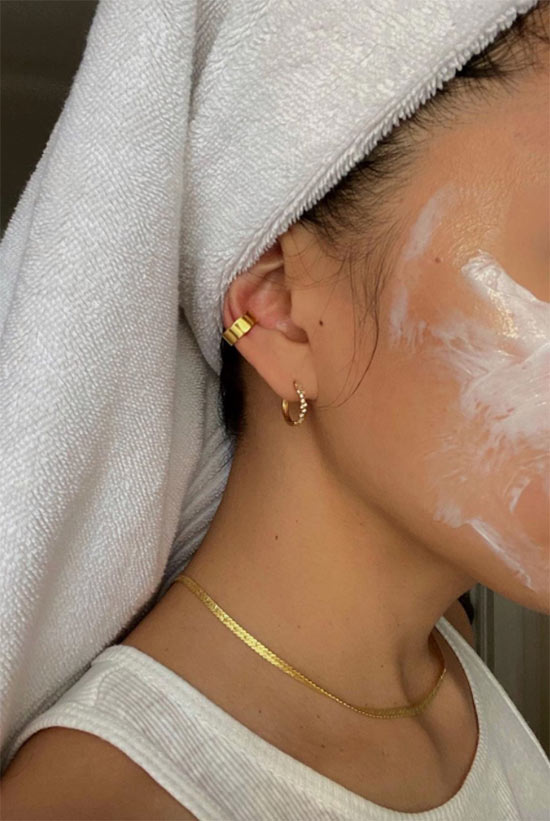When you have sensitive skin, finding skincare that works is a major struggle. Sensitive skin care should be simple: you want products that’ll cure your redness, soothe your itchiness, and make sure your skin never flares up or gets irritated again. That’s why we’ve crafted this guide to building a sensitive skincare routine.
In this article, we explain what it means to have sensitive skin, and how that’s different from having oily or dry skin. We give some key sensitive skincare tips and a thorough guide to patch-testing new products. We’ll explain which ingredients you might want to avoid, and what you should look for in your skincare products instead. Finally, we’ve put together a guide that outlines how to use skincare for sensitive skin at night, in the morning, and for weekly treatments.
In this article:
- What Is Sensitive Skin?
- Skincare Tips for Sensitive Skin
- Patch-Testing Skin Care for Sensitive Skin
- Sensitive Skincare Ingredients to Avoid
- What a Sensitive Skincare Routine Should Do
- The Complete Sensitive Skincare Routine
What Is Sensitive Skin?
Sensitive skin is not like other skin types. In a way, it’s not a skin type at all. Sensitive skin is a term used to describe skin that is very reactive and quick to become inflamed or irritated. The typical signs of sensitivity are chronic redness and visible capillaries, and having skin that is quick to react to things by suddenly turning red, swelling up, becoming hot or itchy, or developing patches of flaky or excessively thick skin.
Inflammation is the skin’s immune response to all kinds of things it perceives as harmful or dangerous. It can become inflamed after it gets burned by the sun or after it becomes infected with something (looking at you, acne bacteria!). For those with sensitive skin, the trouble is that the inflammatory response occurs more frequently and as a result of exposure to too many things. Understanding this is the key to building a sensitive skincare routine.
Sensitive skin can be dry, oily, or somewhere in between. It can also come hand-in-hand (or even be directly caused by) skin conditions like rosacea, acne, seborrheic dermatitis, psoriasis, and more.
Skincare Tips for Sensitive Skin
Here are some very important tips you always need to keep in mind when it comes to your sensitive skin, in order to keep it healthy and to avoid negative reactions.
• Observe Your Skin
It can be difficult to predict which products will work for each person with sensitive skin since triggers can be so individualized. Pay attention to when and why your skin becomes irritated since by knowing your personal triggers, it’ll be easier to avoid them. This doesn’t only apply to skincare and makeup products. You should also pay attention to the detergents you use to wash your clothes, the weather, and the foods you eat.
• Be Consistent and Conservative
If you have sensitive skin, you can’t just change up your skincare products on a whim. It’s important to be consistent with your sensitive skincare routine and to avoid making frequent changes (unless, of course, you’ve had a negative reaction to something).
• Read Beyond the Front Label
When choosing new products to introduce into your skincare routine, don’t rely on just reading the packaging. Words like “hypoallergenic” or the claim that a product is made for sensitive skin are not good enough since there is no organization regulating these claims. Always flip the box or bottle over to read the full ingredient list, so you can tell for yourself if a product is likely to irritate your skin. What ingredients should you watch out for? Keep reading to find out.
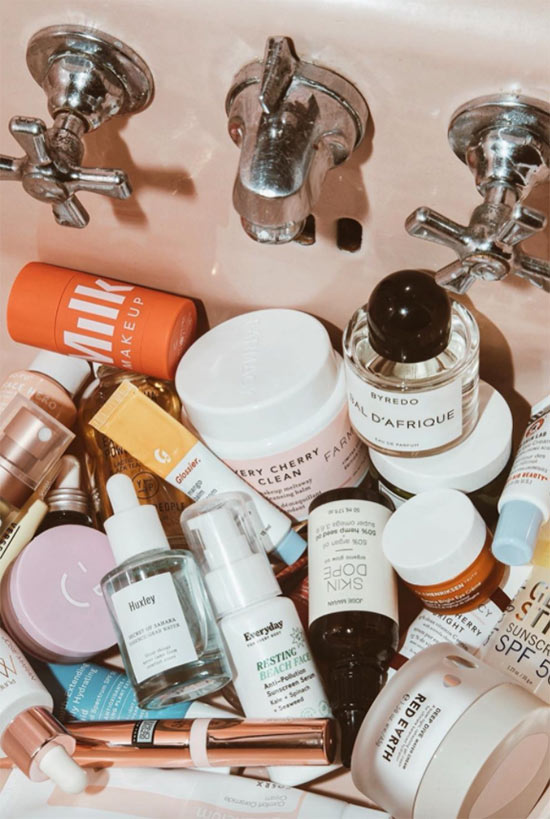
Patch-Testing Skin Care for Sensitive Skin
Patch-testing is the most important habit to cultivate when building your sensitive skincare routine. In dermatology, patch-testing is a comprehensive method that determines allergies. A simple version of it has been adapted to help those with sensitive skin test new skincare products to make sure they’ll be suitable while mitigating risk.
To patch-test a product, you simply need to use it for a few days on a small patch of skin. This way, if the product causes an allergic reaction or contact dermatitis, the reaction will only happen on that small area instead of all over your face.
It’s best to do a patch test on areas where the skin is as thin as the skin on the face but less visible. The forearm, inner upper arm, behind the ear, and side of the neck are all great areas to choose.
For some people with sensitive skin, contact dermatitis may occur after they’ve used a product for a couple of weeks, while for others, a reaction might show up within just a day or two. If it takes a long time for your skin to react to something, plan ahead, and conduct long patch tests.
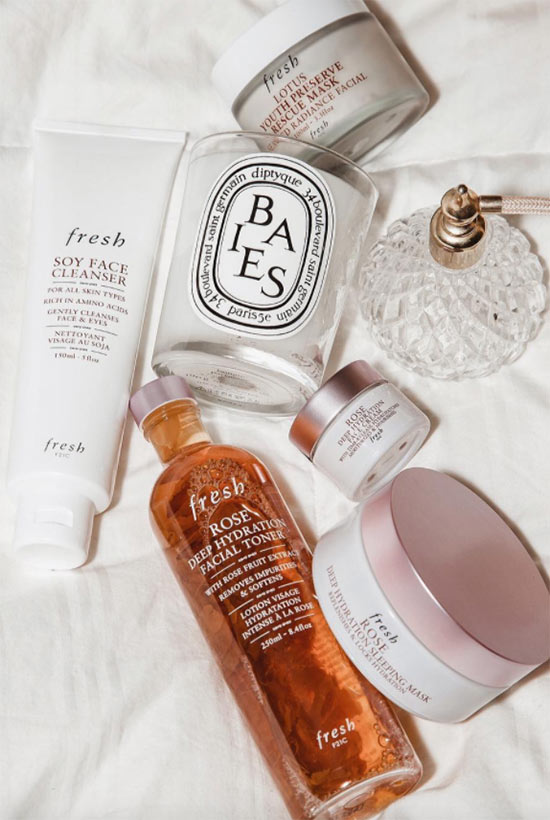
Sensitive Skincare Ingredients to Avoid
What irritates one person’s skin might be fine for another person, but in general, we do know that certain cosmetic ingredients are more likely to be problematic for those with sensitive skin than others. You should try and figure out your personal triggers, but you will likely save yourself a lot of trouble by avoiding the following ingredients.
Fragrances and Essential Oils
According to the FDA, fragrance ingredients are some of the most common culprits for irritation and contact dermatitis. They top our list of irritants because they are far more common than the other ingredients the FDA warns against, like latex, which is only used in some eyelash glues and certain dyes that are only used in hair dye.
Some people with sensitive skin can tolerate specific fragrances and not others, but the issue is that companies don’t have to disclose what their fragrances contain. You can usually see the main “fragrance compounds,” which are listed at the very end, but this would still require you to know which specific fragrance compounds your skin reacts to! If you have sensitive skin, it’s often better to avoid fragrances altogether.
You should be aware that some products might claim to be “fragrance-free” when in reality they contain essential oils, which are just naturally-derived fragrances. Some essential oils can have beneficial effects on the skin, like acne-fighting tea tree oil, but that doesn’t mean they can’t cause irritation. Some essential oils that are recommended for sensitive skin, like lavender and chamomile, can themselves lead to a negative reaction!
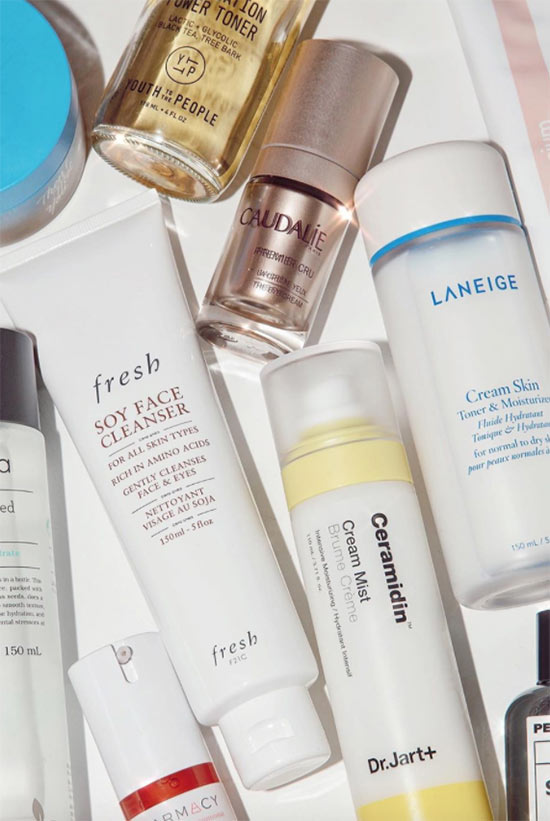
Sulfates and Other Detergents
The cleansing agents used in foaming cleansers are called detergents. They include sulfates like sodium lauryl sulfate, but even the milder ones like decyl glucoside and cocamidopropyl betaine can irritate the skin. This is because their molecules are tiny in size, and they can slip in through the top layers of the stratum corneum if they stay in contact with the skin for too long, which leads to irritation. They can also remove too much oil from the surface of the skin, leaving it dry, dehydrated, and more irritation-prone.
Balm and oil cleansers that clean your skin are a better choice, especially when it comes to makeup removal, which can take a while leaving the cleanser in contact with your skin for longer. While oil cleansers still contain some surfactants, the quantity is lower because they’re only in there to make it easy to rinse the product away.
This doesn’t mean you can’t use foaming cleansers ever again! If you have oily skin, you might need the better oil-removing effects of a cleanser that lathers up. If that’s the case, it’s better to choose a milder gel cleanser like the FAB one we recommended above, to cleanse quickly and to rinse well, so no residue is left on your skin.
Surprisingly, the more different detergents you see on an ingredient list, the less irritating the product will be, while seeing a cleanser that only features one major surfactant is a sign that irritation is more likely. This is because when there are many different detergents in a formula, they tend to stick together and form larger molecules that cannot penetrate the skin as easily.
Finally, some cleansers (especially soap-based ones) are formulated with a pH that is too high, which can wreck the acid mantle and irritate the skin with regular use. Avoid soap-based cleansers and instead look for cleansers advertised as being pH-balanced, which means that they are between 4.5 and 5.5. You can also google the name of a cleanser along with the word “pH level” to find out if it’s optimal or not.
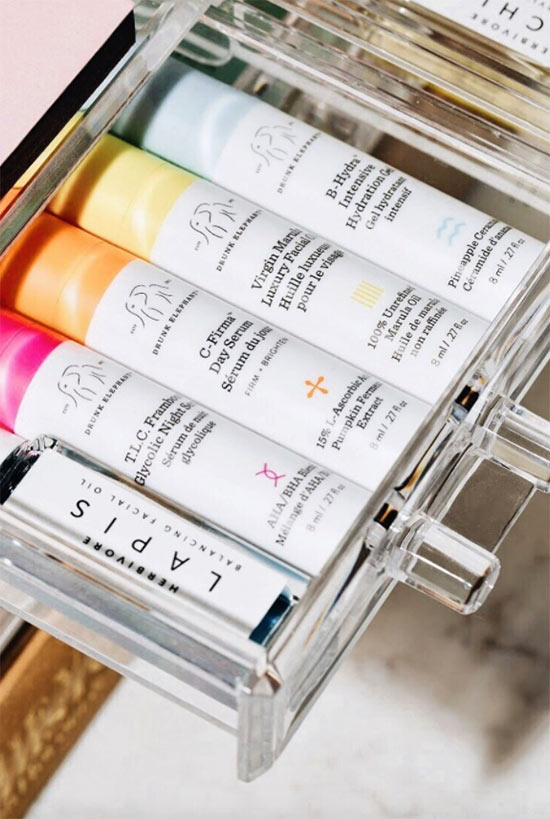
High-Concentration Actives
Unfortunately, with skincare products for sensitive skin, the more powerful an ingredient is, the more likely it is to irritate. There’s a class of ingredients often referred to as “actives” because of how powerful they are. This includes retinoids, glycolic acid, salicylic acid, vitamin C, and even some gentler ingredients like polyhydroxy acids and azelaic acid.
These ingredients are not totally off-limits for sensitive skin, but they should be approached very carefully. It’s better to start with formulas that contain lower percentages or gentler conjugates of the active ingredients (like betaine salicylate instead of salicylic acid or retinyl palmitate instead of retinol).
It’s important not only to patch-test active-based products, but also to introduce them slowly – once or twice a week at first and slowly working your way up to every day or every other day. It’s also important to pay close attention to the skin and to stop using an active ingredient if it aggravates the skin.
Abrasives
In general, it’s best for those with sensitive skin to avoid physical exfoliants (i.e. abrasive powders or beads that physically remove dead skin). Any kind of friction can irritate the skin, so it’s best to avoid it. If you do need to exfoliate your skin but can’t tolerate chemical exfoliants, the gentlest option is to rub the face in circular motions with a damp microfiber face cloth.
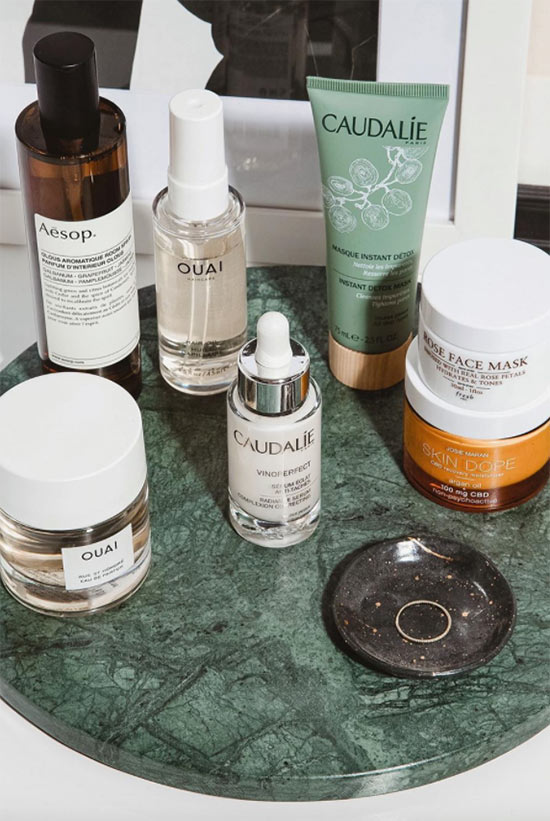
Certain Sunscreens
The idea that those with sensitive skin can only use mineral sunscreens made with zinc oxide or titanium dioxide is mostly a myth, but it’s still true that some of the most common sunscreen ingredients are common irritants. The most common irritating ingredient used in sunscreens is actually fragrance, but the actual sunscreen ingredients like avobenzone, PABA, octocrylene, oxybenzone, and others can also pose a low risk of irritation.
Next-generation sunscreens like Mexoryl XL, Tinsorb, and Uvinul A Plus are less likely to irritate because they’re larger structures that are less able to penetrate the skin.
Long Ingredient Lists
In the same way that the best sensitive skincare routine is minimalist, without extra products or constant changes, the best products for sensitive skin are also minimalist. The more ingredients are in a product, the likelier it is that something in there will be an irritant, and the harder it’ll be for you to figure out which ingredient it was that was the irritant. Make things easier for you and your skin but looking for products with shorter ingredient lists.
What a Sensitive Skincare Routine Should Do
The primary goal of a skincare routine for sensitive skin is to keep the skin strong and calm. As part of the basics, the skin needs to be cleaned and protected from the sun, and moisturizers help the skin act as a good barrier by fortifying its top layers with emollients and hydrators.
Then there are the extras. For those with sensitive skin, beyond simply looking for mild products, it’s important to also look for anti-inflammatories and soothing agents.
A lot of antioxidant ingredients double as soothing agents by protecting the skin from the irritating effects of external aggressors. These include vitamin E, niacinamide, green tea, allantoin, centella asiatica, oat extract, hemp seed extract/CBD, and many more. These are the ingredients that can help calm the skin down when it’s irritated, reduce the look of redness, and help prevent inflammation from occurring in the first place.
Finally, there are the ingredients and products that address your specific concerns. Whether you’re worried about the early signs of aging, the occasional breakout, or something else, it should always be treated after you’ve dealt with the sensitivities first. This is because the active ingredients that deal with your specific concerns are slightly more likely to aggravate irritation.
Look for either gentler conjugates of active ingredients, as we suggested above, or consider targeting your issues with spot treatments instead of all-over products. This can mean only using a salicylic acid spot treatment over the areas where you break out or limiting your strong vitamin C serum to only the areas where you have hyperpigmentation.
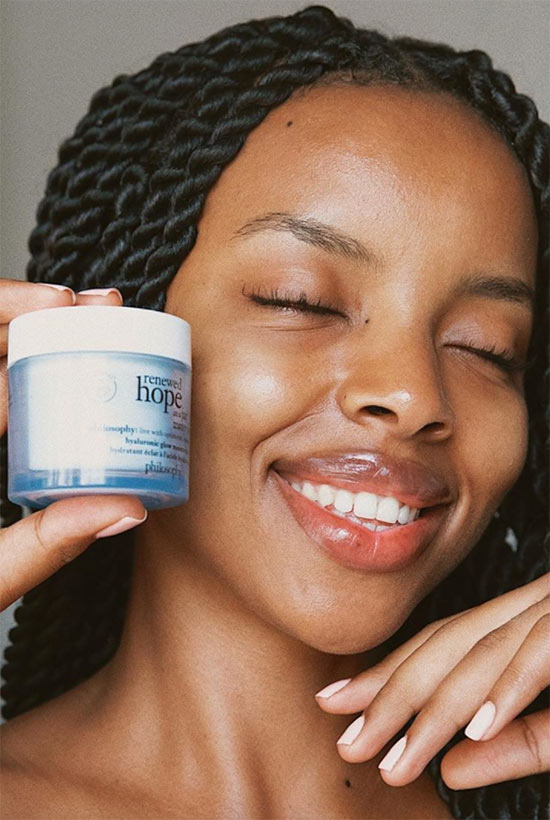
The Complete Sensitive Skincare Routine
With so many product options and so much information, here’s how you actually organize your sensitive skincare routine into night, day, and weekly treatments.
PM Routine
- First things first, cleanse your skin gently. If you’re using a balm or oil cleanser, massage it gently into dry skin and add water to emulsify it once it has broken down all of your sunscreen and makeup. Rinse the cleanser off gently with cool water. If it doesn’t all come off easily, use a soft, damp microfiber cloth to wipe it off.
- If your skin is a little oilier, you might prefer to use a foaming cleanser either in addition to an oil cleanser or instead of it. Dampen your skin and then lightly massage the foaming cleanser. Make sure to use enough cleanser so that your hands glide over your skin, and there is no friction. Rinse or wipe it off completely.
- Next is a toner, which is optional. It’s better to dispense a bit of toner in the palm of your hand and then to splash it on your skin since patting it on with a cotton pad can cause unnecessary friction.
- If you use essence or serum, dispense about a pea-sized amount in the palm of your hand and gently press it into the skin. Avoid rubbing or massaging, which is too rough for sensitive skin.
- Products with azelaic acid, which have the texture of a cream, are best applied after serums but before your moisturizer.
- Finally, you can apply your moisturizer. As with your essences or serums, you will want to press it into your skin in gentle, tapping motions.
- If you use an eye cream, dispense a small drop and tap it around your orbital bone with your ring finger to avoid exerting too much pressure.

AM Routine
- It’s better to avoid cleansing your skin in the morning. Instead, splash your face with some cool water or wipe with a gentle toner.
- If your skin is on the dry side, you will want to load your skin up with soothing, moisturizing products. Start by patting on a soothing serum and follow that up with a moisturizer.
- If your sensitive skin is a little oily, you may want to limit the number of products you put on your face before sunscreen. Just a serum or a gel-based moisturizer will suffice, but for very oily skin, you can go straight into using your sunscreen, especially if it’s a moisturizing formula.
- Applying sunscreen correctly is very important. You will need to use around ¼ teaspoon to cover the entire face. As with other products, press the sunscreen into your skin instead of rubbing it roughly. Splitting it into two applications will help it sink in more easily. Wait 20 minutes before going outside in order to allow the sunscreen to dry down completely.
Weekly Treatments
Your daily skincare routine should already be very soothing, so while using the occasional mask can be nice, it’s not really that important. Instead, a few times a week, you can use stronger products to give your skin some sort of renewing treatment.
When it comes to chemical exfoliants, you’ll want to apply them to your skin just once or twice a week after you’ve cleaned your skin. Afterward, you can apply the rest of your soothing leave-on products. The same applies to non-exfoliating but still slightly acidic products like most vitamin C serums.
With powerful actives that aren’t particularly acidic like retinoids for anti-aging or benzoyl peroxide for acne, it’s better to use them like masks, leaving them on the skin only for 5-10 minutes and then rinsing them off, or to buffer them, by applying them a few times a week in the evening after you’ve already put on hydrating serums and moisturizers. This slows down their rate of penetration in the skin and reduces the chances of irritation.
Photos via @dawn.tan, Instagram

